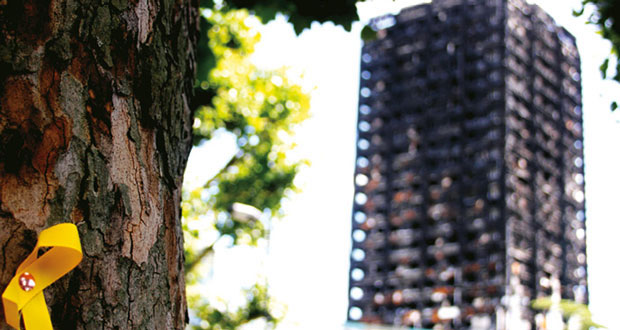The Grenfell Tower Inquiry has today published its second and final report into the circumstances leading up to and surrounding the fire at Grenfell Tower in the early hours of 14 June 2017, which resulted in the deaths of 72 people.
The publication of the Phase 2 report marks the end of a process that began on 15 June 2017 when then Prime Minister Theresa May announced a public inquiry to examine the disaster with a view to ensuring that a similar disaster could never occur again.
The Phase 1 report was published on 30 October 2019 and focused on the events of 14 June 2017: how the fire started, how it escaped from the flat where it had begun and how it spread over the whole building with tragic consequences.
Phase 2 of the Inquiry examined the underlying causes of the fire to identify where mistakes were made and how Grenfell Tower came to be in a condition which allowed the fire to spread in the way identified by Phase 1. It also investigated the response of the authorities to the emergency.
Introducing the report, Inquiry Chairman the Rt Hon Sir Martin Moore-Bick explained that the second part of the investigations had taken longer than originally hoped because, as those investigations progressed, the Inquiry uncovered many more matters of concern than had previously been expected.
The Inquiry report finds that the deaths that occurred were all avoidable “and that those who lived in Grenfell Tower were badly failed over a number of years by those who were responsible for ensuring the safety of its occupants”.
Sir Martin said: “They include the government, the Tenant Management Organisation, the Royal Borough of Kensington and Chelsea, those who manufactured and supplied the materials used in the refurbishment, those who certified their suitability for use on high-rise residential buildings, the architect, Studio E, the principal contractor, Rydon Maintenance Ltd, and some of its sub-contractors, in particular, Harley Curtain Wall Ltd and its successor Harley Facades Ltd, some of the consultants, in particular the fire engineer, Exova Warringtonfire Ltd, the local authority’s building control department and the London Fire Brigade.”
Sir Martin went on to explain that while not all of them bear the same degree of responsibility for the eventual disaster, “all contributed to it in one way or another, in most cases through incompetence but in some cases through dishonesty and greed”.
Panel member and architect Thouria Istephan, who spent nearly 30 years as an architect before joining the Inquiry in 2020, said: “Our report identifies what we think is needed to make sure that the legacy of Grenfell is real and brings about lasting change. Our recommendations place new burdens
and responsibilities on people and organisations.”
Istephan continued: “I make no apologies for that: put simply, if you work in the construction industry and you do not feel the weight of the responsibility you have for keeping people safe – you are in the wrong job.”
Former housing association Chief Executive Ali Akbor OBE, who joined the Inquiry as a Panel Member in 2020, said: “I hope that our report acts as a reminder to the clients of future building projects – including social housing providers – that they have a responsibility to the users of their buildings to ensure that safety is not sacrificed to the demands of speed and cost.”
Recommendations put forward by the Inquiry panel include:
- Bringing responsibility for all aspects of fire safety under one government Department.
- The appointment of a construction regulator to oversee all aspects of the construction industry.
- The establishment of a body of professional fire engineers, properly regulated and with protected status and the introduction of mandatory fire safety
strategies for higher-risk buildings. - A licensing scheme for contractors wishing to undertake the construction or refurbishment of higher-risk buildings.
- The regulation and mandatory accreditation of fire risk assessors.
- The establishment of a College of Fire and Rescue to provide practical, educational and managerial training to fire and rescue services.
- The introduction of a requirement for the government to maintain a publicly accessible record of recommendations made by select committees, coroners and public inquiries, describing the steps taken in response or its reasons for declining to implement them.
To read the Grenfell Inquiry phase 2 report click here.
Peter McGettrick, Chairman of British Safety Council, said: “We welcome the publication of the final report by the Grenfell Tower Inquiry. It is a sobering and comprehensive report which has brought forensic attention to the institutional failings that led to this tragedy, the responsibility for which must be shared across multiple stakeholders.
“Safety must be at the core of any changes, and we need to see an appropriate and proportionate response by all parties, which delivers on the recommendations in the Inquiry’s report and ensures greater clarity, transparency and professionalism at all levels. Progress has been made in the past seven years, especially in terms of new legislation and regulation on building safety and social housing, but there is clearly much more to do. The Inquiry’s recommendations build on this and we look forward to the Government’s response and action to deliver on them.”
CIBSE Technical Director, Dr Anastasia Mylona, commented: “The findings of the Grenfell Inquiry report are both sobering and a stark reminder of the critical need for transparency, integrity and robust regulation within our industry. As the report highlights systemic failures, CIBSE remains committed to driving the necessary reforms in building and fire safety engineering practices. Our role is to ensure that the highest standards are upheld, and that the safety of residents is always the paramount concern in the built environment.“
Andrew Parker, Head of the Construction Disputes and Building Safety practices at law firm Forsters, commented: “A key finding is that government was given plenty of warning as far back as 1991 of the risks of combustible cladding panels and insulation, particularly on higher-rise buildings, and so had opportunities to take action but failed to do so.
“The arrangements for procuring works to higher-risk buildings have been found to be deficient. There is a clear message that the way key members of the construction industry have been regulated and trained needs to change and guidance provided by government for compliance with the relevant legislation needs to be improved. Regulation of the construction industry has become too complex and fragmented.
“There will be tighter regulation of fire engineers and contractors which, depending on the timescale for implementation, may squeeze an already resource-starved area of the industry.
“Although no express requirements have been placed on architects, the ARB and RIBA have been encouraged to review the changes they have already implemented for the education and training of architects and when taken in the context of the Inquiry’s finding that there may have been a ‘widespread failure’ among the architectural profession, the review that has been recommended may well lead to tighter regulation of architects as well.
“There are no additional requirements being placed on clients who commission building work, but we can expect the already-introduced compliance statement signed by clients to be strictly enforced following its endorsement by the Inquiry.
“There is an emphasis on protecting vulnerable people in whatever building they are in, not determined necessarily by the height of the building. A review of the definition of a higher-risk building will bring a larger number of buildings within the scope of the strict requirements introduced by the Building Safety Act. Fire strategies will need to be reviewed and possibly amended to take account of the needs of vulnerable people and the nature of the building’s use.”
CIC (Construction Industry Council) stated: “Whilst much work has already been done through the independent review of building regulations and fire safety undertaken by Dame Judith Hackitt and the consequent programme of regulatory reform that has been introduced and which the industry is working hard to implement, Sir Martin has clearly identified several further matters that require attention and CIC will be working with its members, the wider industry and government to develop appropriate responses to those matters, ensuring that they are given the critical and expedient attention that they demand.
“It will take time to give the thought and consideration that the report requires and for the action that is needed to address the various recommendations Sir Martin has brought forward. It is essential that government and the construction sector recognise the findings he has reported and that we learn the lessons and continue to respond to create an industry and a culture where safety, competence and compliance with the law is an absolute priority. Only then will public trust in the sector be restored.
“CIC believes that every construction professional should fully familiarise themselves with the report and its recommendations, and we will work closely with our members to facilitate this process as we develop an appropriate detailed response to the report.”
Nicola John, Managing Director at Fire Door Maintenance (FDM), part of UAP said: “The Grenfell Inquiry Phase 2 report underscores the vital need for rigorous fire door maintenance and compliance. The failure of fire doors during the Grenfell tragedy is a stark reminder of the importance of maintaining these life-saving systems according to manufacturers’ guidelines. We need mandatory, detailed inspections for all buildings, regardless of height, and greater accountability across the industry. That’s why FDM is advocating for a central register of qualified operatives—inspectors, maintainers, and installers—so that we can ensure fire doors consistently meet the highest safety standards and prevent future tragedies. It’s something the industry direly needs, and FDM is bridging the gap, providing holistic training for the industry in order to make this a reality.”
ECA Director of Technical and HS&E Mike Smith said: “We welcome changes made to the Building Regulations, particularly duties to employ competent organisations and individuals, ensure collaboration within design and construction teams, mandate reporting of compliance and safety issues, and professionalise consent and approvals processes.
“Enforcement of the rules has historically been a weak spot. Which is why we strongly support the introduction of the Building Safety Regulator, to oversee changes and deploy a strict regime for higher risk buildings that continues through the life of the building.”





